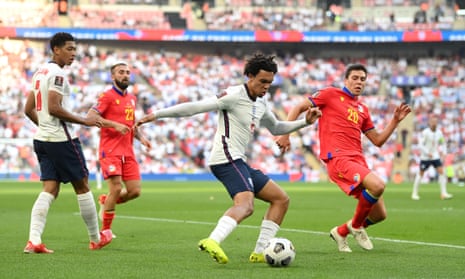England have a tendency to fix a troublesome position by filling it with a non-specialist on the assumption he can probably do a job there. For instance, when Sven-Göran Eriksson was faced with a shortage of competent left-footed midfielders, one of his attempted solutions was deploying Wayne Bridge in front of Ashley Cole for a Euro 2004 qualifier against Macedonia.
It was not the worst idea. Bridge and Cole were excellent attacking left-backs and there was merit in starting them in the same team. It was certainly preferable to cramming in yet another right-footer at left midfield and Eriksson’s plan may well have worked had England not been so wedded to playing a rigid 4-4-2.
After all, Scotland have found a way to use Andy Robertson and Kieran Tierney, picking the former at left wing-back and the latter as a left-sided centre-back. Perhaps, with a little more care, Eriksson could have made the Bridge-Cole combination work. But England were still playing in straight lines when they faced Macedonia. It finished 2-2 and, although Bridge played quite well, the plan was quietly shelved and England’s left-sided dilemma went on, a weakness matched only by their inability to find a midfield controller.
Central midfield: it has been quite a problem for England. There was the great Lampard-Gerrard conundrum and at Euro 2016 Roy Hodgson decided his midfield would benefit from the inclusion of Wayne Rooney, who was well past his peak as a striker.
The sensible move would have been dropping Rooney. The reasons given for playing him in the middle – he has a great passing range, he can shoot, he can cross, he has unrivalled nous, he is too good to leave out – were superficial, exposed as such when England lost to Iceland, and worryingly similar to the logic behind the push to recast Trent Alexander-Arnold as a central midfielder.
Alexander-Arnold started there against Andorra on Sunday, shuffling around uncomfortably during the first 45 minutes of England’s 4-0 win. The 22-year-old never seemed to know where he was meant to be – in contrast to Jude Bellingham, who was always in the right place – and often drifted over to England’s right-back, Reece James. “We just wanted to see something,” Gareth Southgate said. “This was a good game to look at it.”
It undoubtedly was, given Andorra are ranked 156th in the world. There was no better time to experiment and Southgate is right to look at alternative options to Declan Rice, Kalvin Phillips and Mason Mount in midfield. As defeat by Italy in the Euro 2020 final showed, England have to add more craft and poise on the ball before next year’s World Cup.
That does not necessarily make Alexander-Arnold the answer. Yes, he has a wicked right foot, brilliant technique and superb passing ability. Yes, Germany’s Philipp Lahm and Joshua Kimmich excelled after moving from full-back to midfield but the skills that mark out Alexander-Arnold as a special talent are ones he has honed as a right-back. Without training and experience, his raw qualities will not give him an understanding of the subtleties of playing in midfield.
Crucially Alexander-Arnold does not sound like someone itching to change his position. He does not play in midfield for Liverpool and he has previously spoken about his desire to redefine the role of full-back. This matters: Alexander-Arnold likes being a right-back. Playing there has made him famous and he looked much happier against Andorra after moving back into defence in the second half.
It was not a surprise. This is a player described by Southgate as a “playmaker from right-back”. The problem, though, is that England have an embarrassment of riches in Alexander-Arnold’s position. Kyle Walker, Kieran Trippier and James are three of the best right-backs in the world and have performed excellently for England. Alexander-Arnold last week described his performances for his country as mediocre.
It was admirably honest from Alexander-Arnold, whose England place remains uncertain. Dropped by Southgate in March, he missed the Euros through injury and is yet to reproduce his club form on the international stage. His defending has to improve and, after the sense of confusion against Andorra, it is not hard to conclude Southgate cannot continue to include four right-backs in his squad.
It feels like a fudge. For all the talk about the flexibility of England’s right-backs, there is not much point picking Alexander-Arnold if he is fourth choice in his most effective position. It means taking a place away from someone in another position, weakening England’s depth, and visions of Alexander-Arnold as a midfielder are unlikely to become a reality unless he starts playing there for Liverpool. There has to be the will to make it work. Otherwise it will only ever be a tantalising theory.
